KIA Optima 2013 3.G Owner's Guide
Manufacturer: KIA, Model Year: 2013, Model line: Optima, Model: KIA Optima 2013 3.GPages: 382, PDF Size: 8.75 MB
Page 21 of 382
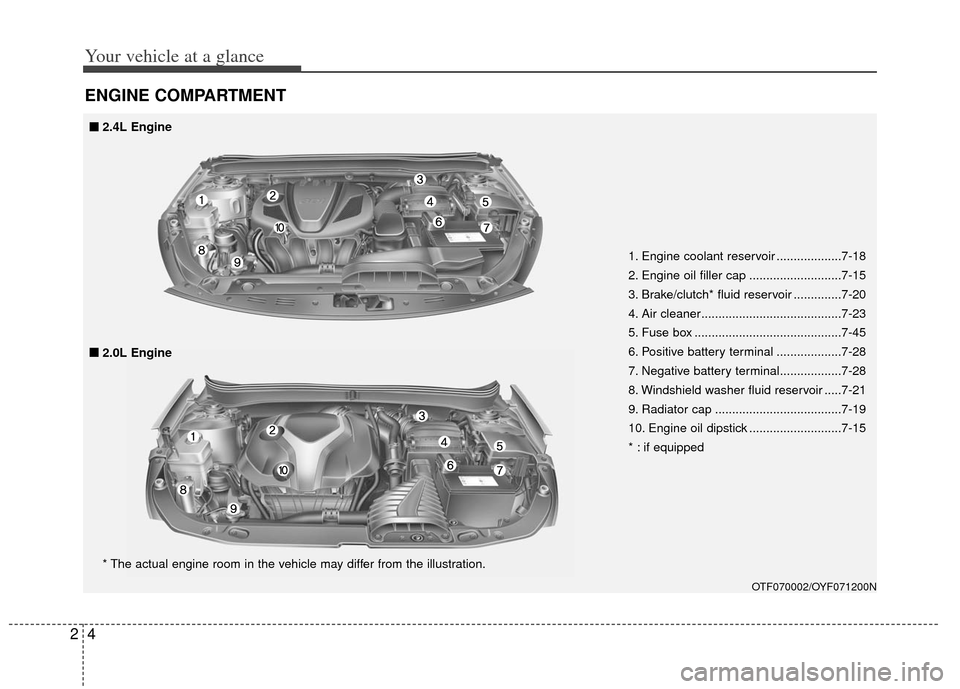
Your vehicle at a glance
42
ENGINE COMPARTMENT
1. Engine coolant reservoir ...................7-18
2. Engine oil filler cap ...........................7-15
3. Brake/clutch* fluid reservoir ..............7-20
4. Air cleaner.........................................7-23
5. Fuse box ...........................................7-45
6. Positive battery terminal ...................7-28
7. Negative battery terminal..................7-28
8. Windshield washer fluid reservoir .....7-21
9. Radiator cap .....................................7-19
10. Engine oil dipstick ...........................7-15
* : if equipped
OTF070002/OYF071200N
* The actual engine room in the vehicle may differ from the illustration.
■
■
2.4L Engine
■
■ 2.0L Engine
Page 22 of 382
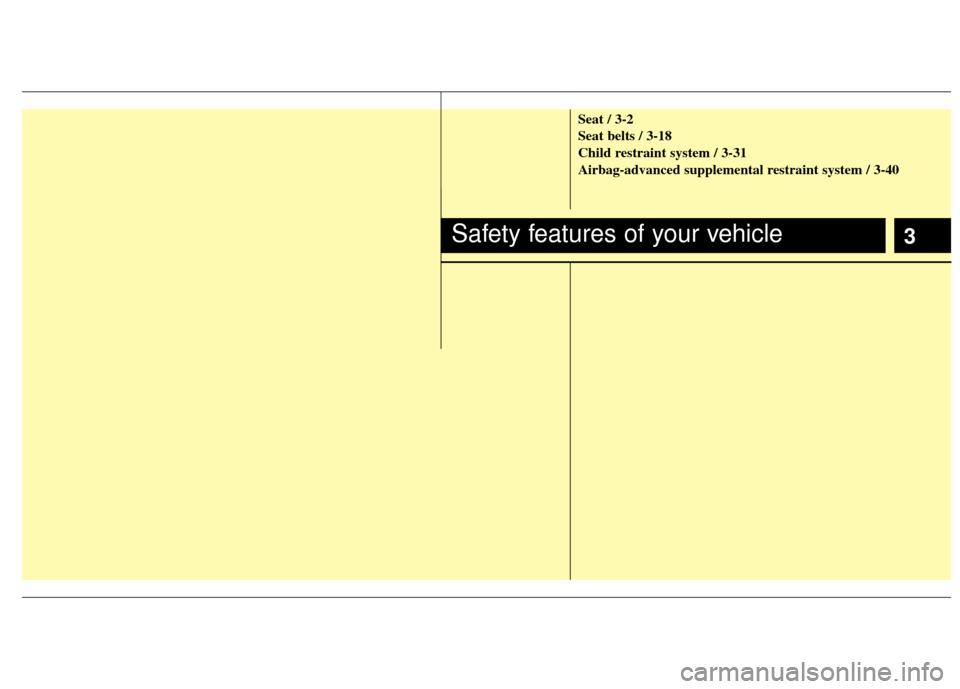
3
Seat / 3-2
Seat belts / 3-18
Child restraint system / 3-31
Airbag-advanced supplemental restraint system / 3-40
Safety features of your vehicle
Page 23 of 382
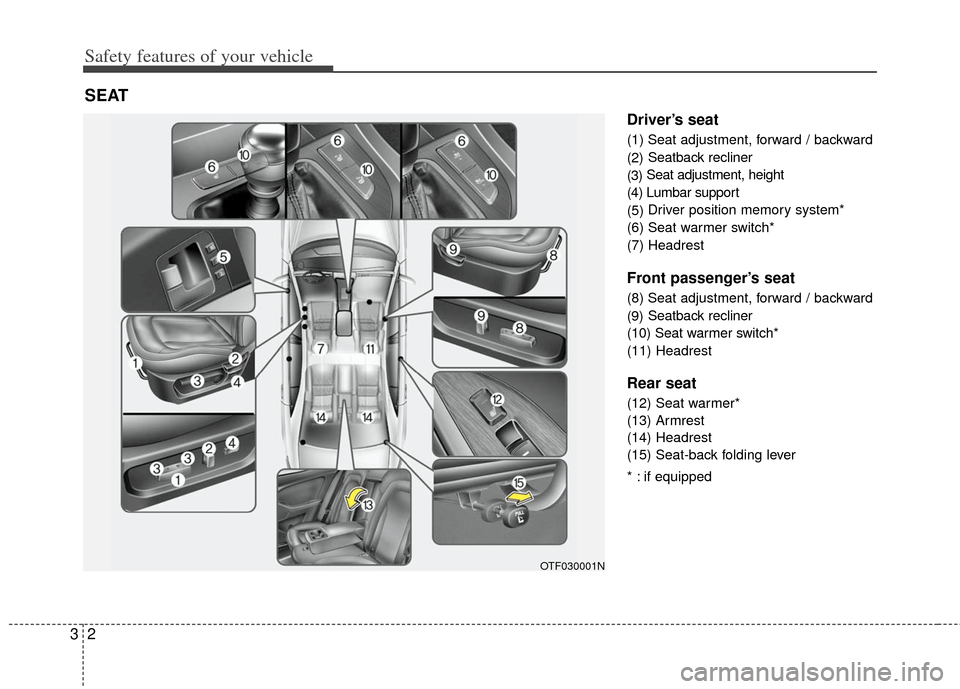
Safety features of your vehicle
23
Driver’s seat
(1) Seat adjustment, forward / backward
(2)Seatback recliner
(3) Seat adjustment, height
(4) Lumbar support
(5) Driver position memory system*
(6) Seat warmer switch*
(7) Headrest
Front passenger’s seat
(8) Seat adjustment, forward / backward
(9) Seatback recliner
(10) Seat warmer switch*
(11) Headrest
Rear seat
(12) Seat warmer*
(13) Armrest
(14) Headrest
(15) Seat-back folding lever
* : if equipped
SEAT
OTF030001N
Page 24 of 382
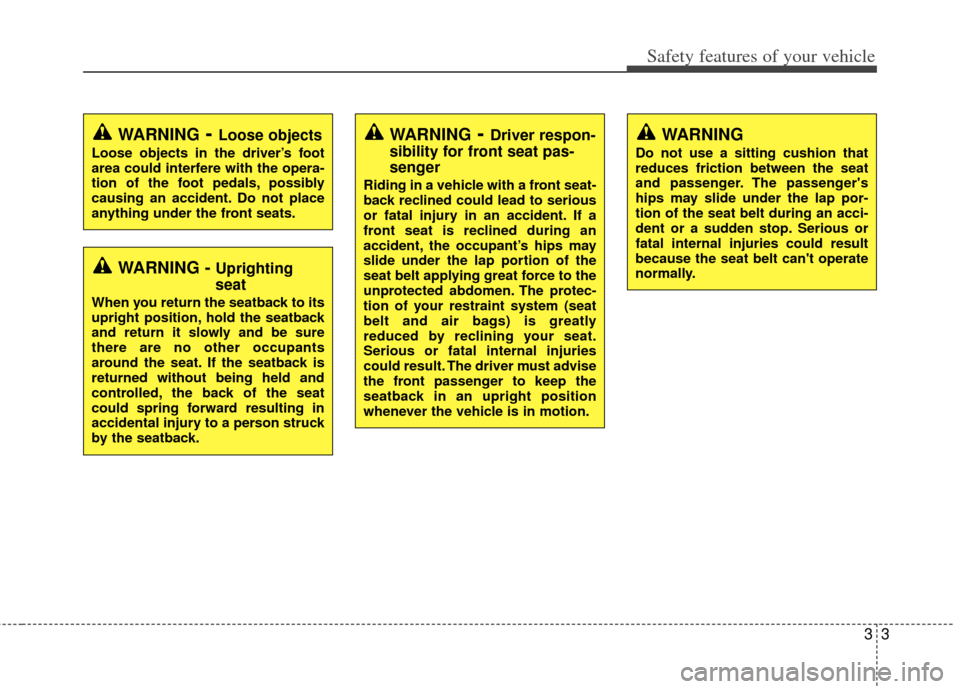
33
Safety features of your vehicle
WARNING - Uprighting
seat
When you return the seatback to its
upright position, hold the seatback
and return it slowly and be sure
there are no other occupants
around the seat. If the seatback is
returned without being held and
controlled, the back of the seat
could spring forward resulting in
accidental injury to a person struck
by the seatback.
WARNING- Loose objects
Loose objects in the driver’s foot
area could interfere with the opera-
tion of the foot pedals, possibly
causing an accident. Do not place
anything under the front seats.
WARNING- Driver respon-
sibility for front seat pas-
senger
Riding in a vehicle with a front seat-
back reclined could lead to serious
or fatal injury in an accident. If a
front seat is reclined during an
accident, the occupant’s hips may
slide under the lap portion of the
seat belt applying great force to the
unprotected abdomen. The protec-
tion of your restraint system (seat
belt and air bags) is greatly
reduced by reclining your seat.
Serious or fatal internal injuries
could result. The driver must advise
the front passenger to keep the
seatback in an upright position
whenever the vehicle is in motion.
WARNING
Do not use a sitting cushion that
reduces friction between the seat
and passenger. The passenger's
hips may slide under the lap por-
tion of the seat belt during an acci-
dent or a sudden stop. Serious or
fatal internal injuries could result
because the seat belt can't operate
normally.
Page 25 of 382
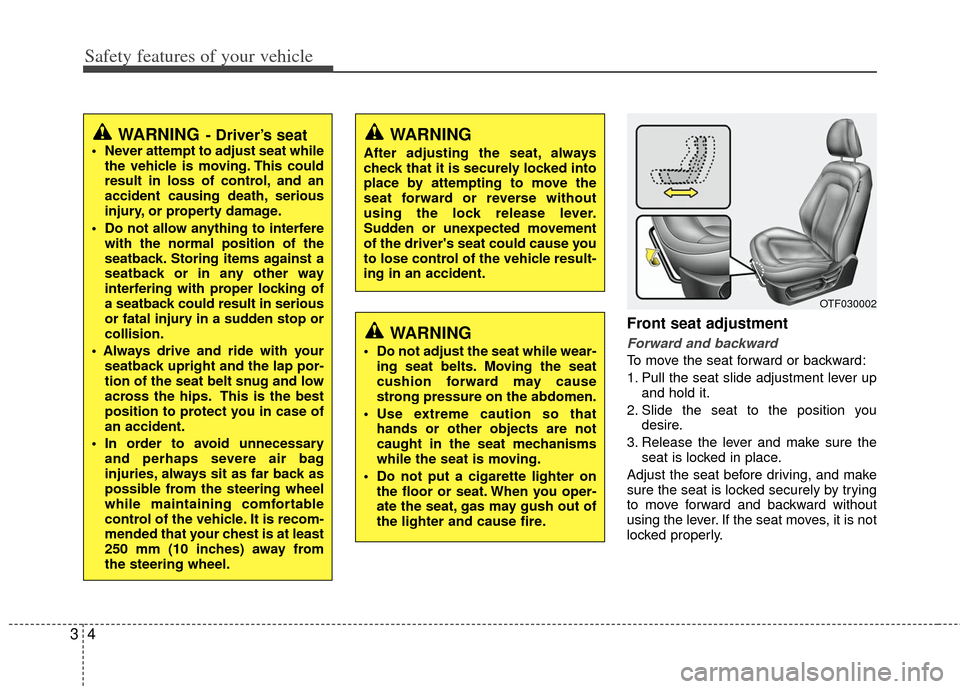
Safety features of your vehicle
43
Front seat adjustment
Forward and backward
To move the seat forward or backward:
1. Pull the seat slide adjustment lever upand hold it.
2. Slide the seat to the position you desire.
3. Release the lever and make sure the seat is locked in place.
Adjust the seat before driving, and make
sure the seat is locked securely by trying
to move forward and backward without
using the lever. If the seat moves, it is not
locked properly.
OTF030002
WARNING
After adjusting the seat, always
check that it is securely locked into
place by attempting to move the
seat forward or reverse without
using the lock release lever.
Sudden or unexpected movement
of the driver's seat could cause you
to lose control of the vehicle result-
ing in an accident.
WARNING
Do not adjust the seat while wear- ing seat belts. Moving the seat
cushion forward may cause
strong pressure on the abdomen.
Use extreme caution so that hands or other objects are not
caught in the seat mechanisms
while the seat is moving.
Do not put a cigarette lighter on the floor or seat. When you oper-
ate the seat, gas may gush out of
the lighter and cause fire.
WARNING- Driver’s seat Never attempt to adjust seat whilethe vehicle is moving. This could
result in loss of control, and an
accident causing death, serious
injury, or property damage.
Do not allow anything to interfere with the normal position of the
seatback. Storing items against a
seatback or in any other way
interfering with proper locking of
a seatback could result in serious
or fatal injury in a sudden stop or
collision.
seatback upright and the lap por-
tion of the seat belt snug and low
across the hips. This is the best
position to protect you in case of
an accident.
In order to avoid unnecessary and perhaps severe air bag
injuries, always sit as far back as
possible from the steering wheel
while maintaining comfortable
control of the vehicle. It is recom-
mended that your chest is at least
250 mm (10 inches) away from
the steering wheel.
Page 26 of 382
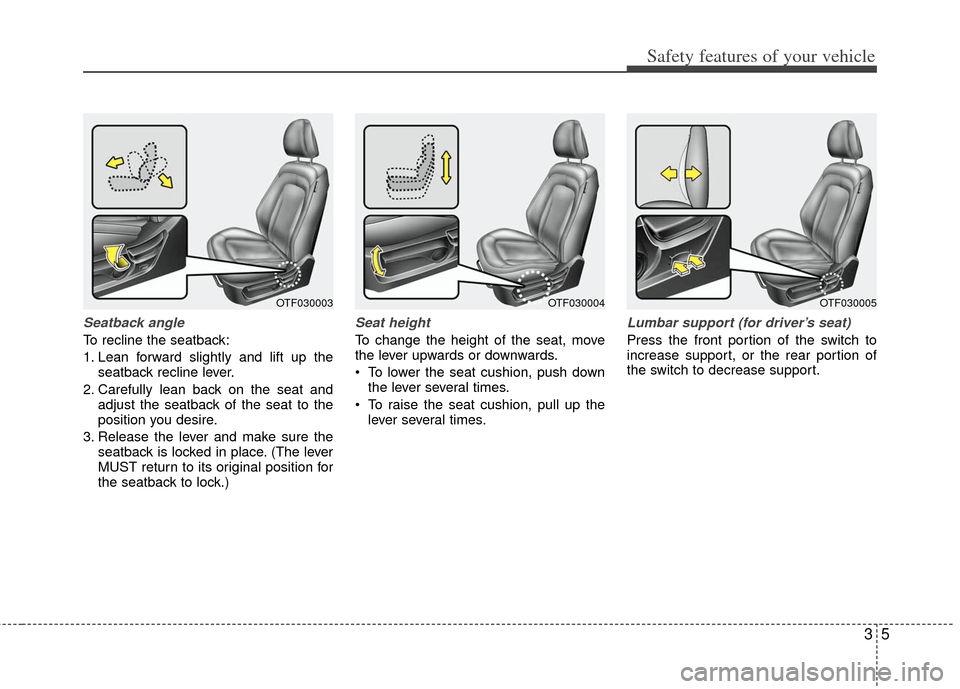
35
Safety features of your vehicle
Seatback angle
To recline the seatback:
1. Lean forward slightly and lift up theseatback recline lever.
2. Carefully lean back on the seat and adjust the seatback of the seat to the
position you desire.
3. Release the lever and make sure the seatback is locked in place. (The lever
MUST return to its original position for
the seatback to lock.)
Seat height
To change the height of the seat, move
the lever upwards or downwards.
• To lower the seat cushion, push downthe lever several times.
To raise the seat cushion, pull up the lever several times.
Lumbar support (for driver’s seat)
Press the front portion of the switch to
increase support, or the rear portion of
the switch to decrease support.
OTF030003OTF030004OTF030005
Page 27 of 382
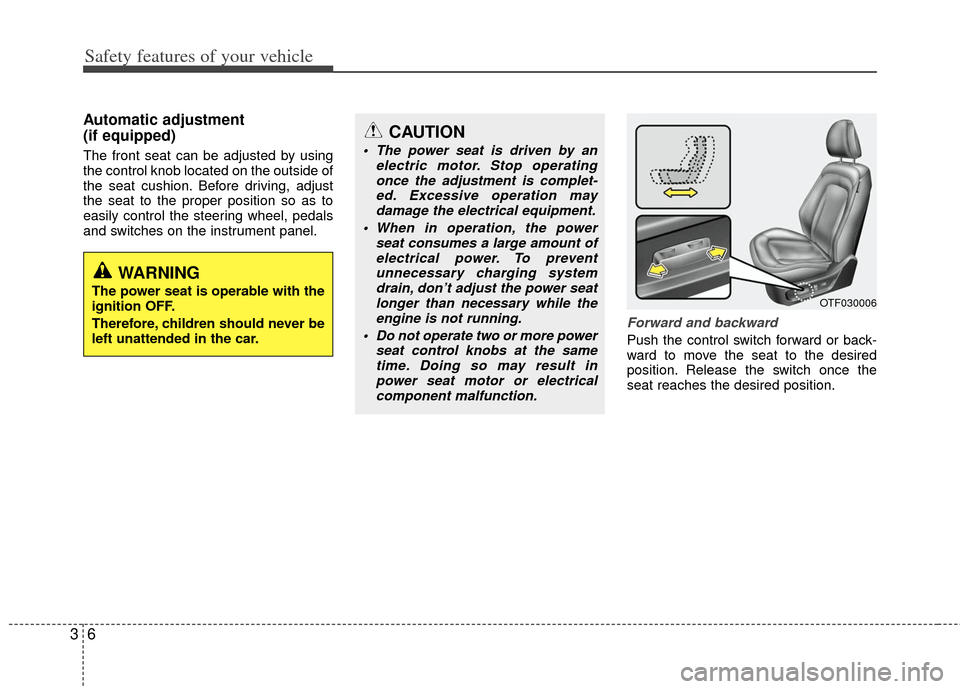
Safety features of your vehicle
63
Automatic adjustment
(if equipped)
The front seat can be adjusted by using
the control knob located on the outside of
the seat cushion. Before driving, adjust
the seat to the proper position so as to
easily control the steering wheel, pedals
and switches on the instrument panel.
Forward and backward
Push the control switch forward or back-
ward to move the seat to the desired
position. Release the switch once the
seat reaches the desired position.
CAUTION
The power seat is driven by anelectric motor. Stop operatingonce the adjustment is complet-ed. Excessive operation maydamage the electrical equipment.
When in operation, the power seat consumes a large amount ofelectrical power. To preventunnecessary charging systemdrain, don’t adjust the power seatlonger than necessary while theengine is not running.
Do not operate two or more power seat control knobs at the sametime. Doing so may result inpower seat motor or electricalcomponent malfunction.
OTF030006
WARNING
The power seat is operable with the
ignition OFF.
Therefore, children should never be
left unattended in the car.
Page 28 of 382
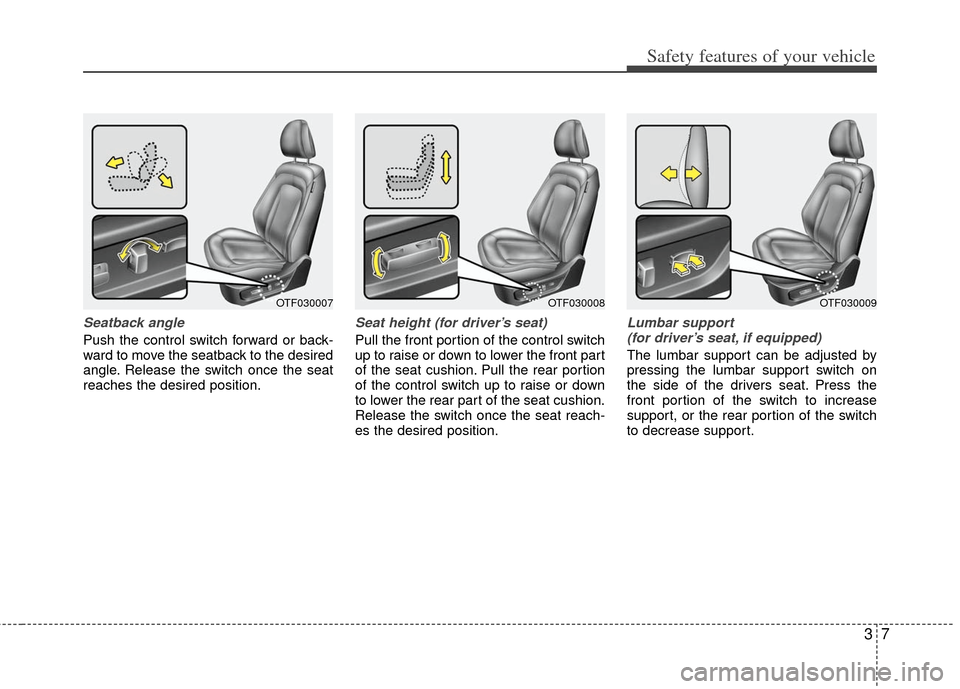
37
Safety features of your vehicle
Seatback angle
Push the control switch forward or back-
ward to move the seatback to the desired
angle. Release the switch once the seat
reaches the desired position.
Seat height (for driver’s seat)
Pull the front portion of the control switch
up to raise or down to lower the front part
of the seat cushion. Pull the rear portion
of the control switch up to raise or down
to lower the rear part of the seat cushion.
Release the switch once the seat reach-
es the desired position.
Lumbar support (for driver’s seat, if equipped)
The lumbar support can be adjusted by
pressing the lumbar support switch on
the side of the drivers seat. Press the
front portion of the switch to increase
support, or the rear portion of the switch
to decrease support.
OTF030007OTF030008OTF030009
Page 29 of 382

Safety features of your vehicle
83
Headrest
The driver's and front passenger's seats
are equipped with a headrest for the
occupant's safety and comfort.
The headrest not only provides comfort
for the driver and front passenger, but
also helps to protect the head and neck
in the event of a collision.Forward and backward adjustment
The headrest may be adjusted forward to
3 different positions by pulling the head-
rest forward to the desired detent. To
adjust the headrest to it’s furthest back-
wards position, pull it fully forward to the
farthest position and release it. Adjust the
headrest so that it properly supports the
head and neck.
WARNING
For maximum effectiveness in
case of an accident, the headrest
should be adjusted so the middle
of the headrest is at the same
height of the center of gravity of
an occupant's head. Generally,
the center of gravity of most peo-
ple's head is similar with the
height of the top of their eyes.
Also, adjust the headrest as close
to your head as possible. For this
reason, the use of a cushion that
holds the body away from the
seatback is not recommended.
Do not operate the vehicle with the headrests removed as severe
injury to the occupants may
occur in the event of an accident.
Headrests may provide protec-
tion against neck injuries when
properly adjusted.
Do not adjust the headrest posi- tion of the driver's seat while the
vehicle is in motion.
OTF030012OMG038400
Page 30 of 382

39
Safety features of your vehicle
Adjusting the height up and down
To raise the headrest, pull it up to the
desired position (1). To lower the head-
rest, push and hold the release button (2)
on the headrest support and lower the
headrest to the desired position (3).Removal
To remove the headrest, raise it as far as
it can go then press the release button (1)
while pulling the headrest upward (2).
To reinstall the headrest, put the head-
rest poles (3) into the holes while press-
ing the release button (1). Then adjust it
to the appropriate height.
Seat warmer (if equipped)
The seat warmer is provided to warm the
front seats during cold weather. While the
engine is running, push either of the
switches to warm the driver's seat or the
front passenger's seat.
During mild weather or under conditions
where the operation of the seat warmer
is not needed, keep the switches in the
OFF position.
OTF030010OTF030011
OTF030013N
OTF030045N